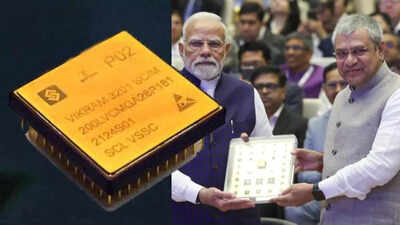ARTICLE AD BOX

Union Information and Broadcasting Minister Ashwini Vaishnaw recently unveiled India’s first indigenously developed
32-bit processor
called Vikram-32. The minister presented the microchip to Prime Minister Narendra Modi at the inauguration of the Semicon India 2025 conference.
Vikram-32
microchip has been developed by the Indian Space Research Organisation (ISRO)'s Semiconductor Laboratory (SCL), Chandigarh. It is said to be specifically designed to withstand extreme conditions of rocket launches and space environments. Here’s everything you need to know about Vikram-32 microchip
What is Vikram-32
Vikram-32 is successor to the VIKRAM160 – a 16-bit microprocessor that has powered ISRO's launch vehicles since 2009. A “Make-in-India” version of the VIKRAM1601 processor was subsequently inducted in 2016 after the 180nm semiconductor fab was established at SCL. VIKRAM3201 & the VIKRAM1601 has a custom Instruction Set Architecture, with floating-point computation capability and high-level language support for the Ada language. All the software tools such as the Ada compiler, assembler, linker, simulator along with Integrated Development Environment (IDE) are developed in-house by ISRO.
The initial lot of VIKRAM3201 devices was successfully validated in space in the Mission Management Computer of the PSLV Orbital Experimental Module (POEM-4) in the PSLV-C60 mission.These microprocessors have been designed & developed by the
Vikram Sarabhai Space Centre
of ISRO in collaboration with SCL.
Features of Vikarm-32
The Vikram 32 is powered by a 32-bit microprocessor and operates on a single 3.3V supply with a clock speed of 100 MHz. It is designed for efficiency, drawing a quiescent supply current of less than 10 mA and consuming under 500 mW of power during operation.The processor functions reliably across a wide temperature range from -55ºC to 125ºC and comes with built-in testability features, including scan and functional modes. It is packaged in a 181-pin CPGA.Supporting 152 instructions, the Vikram 32 offers a 20-bit external address bus, 256 software interrupts, and four 32-bit timers. For communication, it integrates two on-chip 1553B bus interfaces.The microprocessor is developed using SCL’s 180nm CMOS technology, ensuring robust performance and integration.
Apple's Foldable iPhone is Coming, Here’s Why it Matters



.png)
.png)
.png)
















 2 days ago
3
2 days ago
3








 English (US) ·
English (US) ·